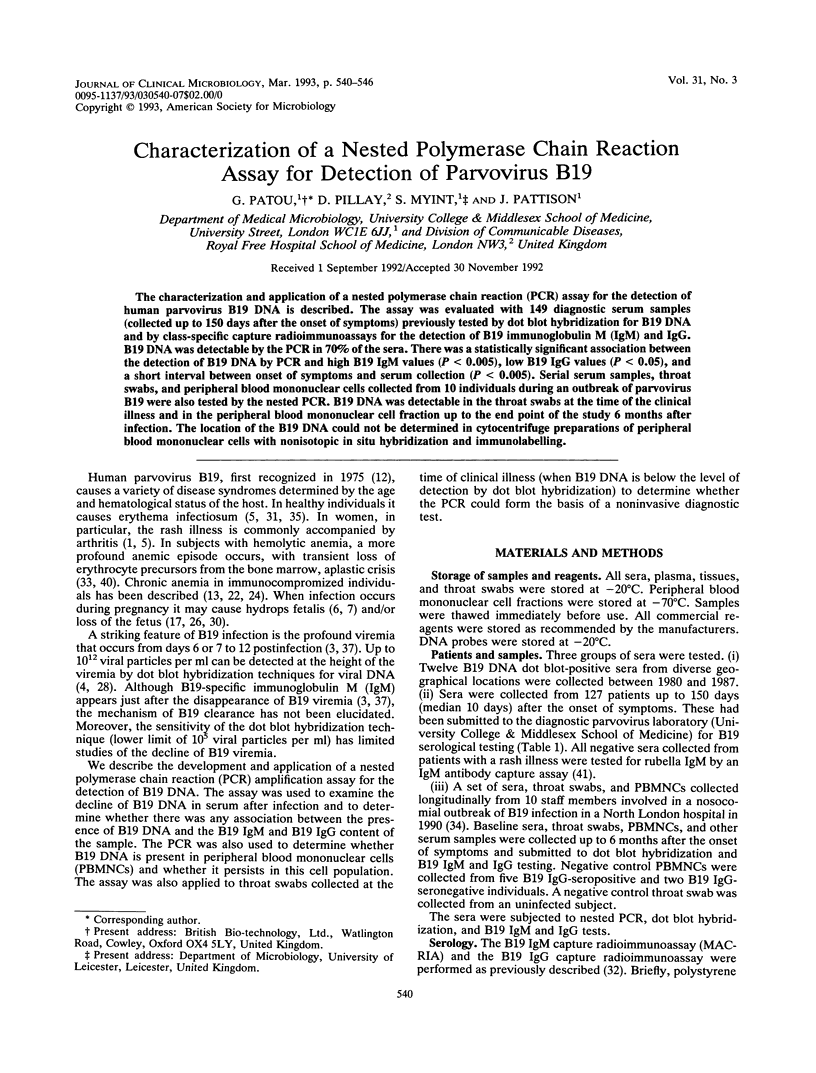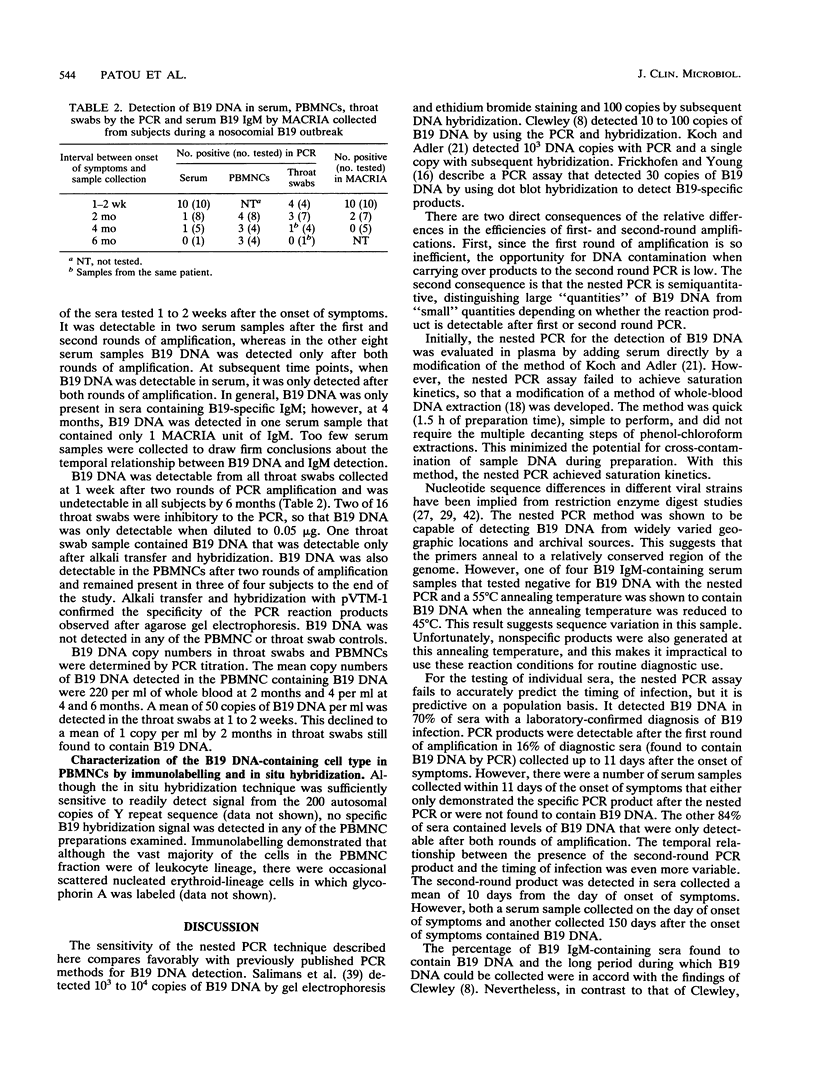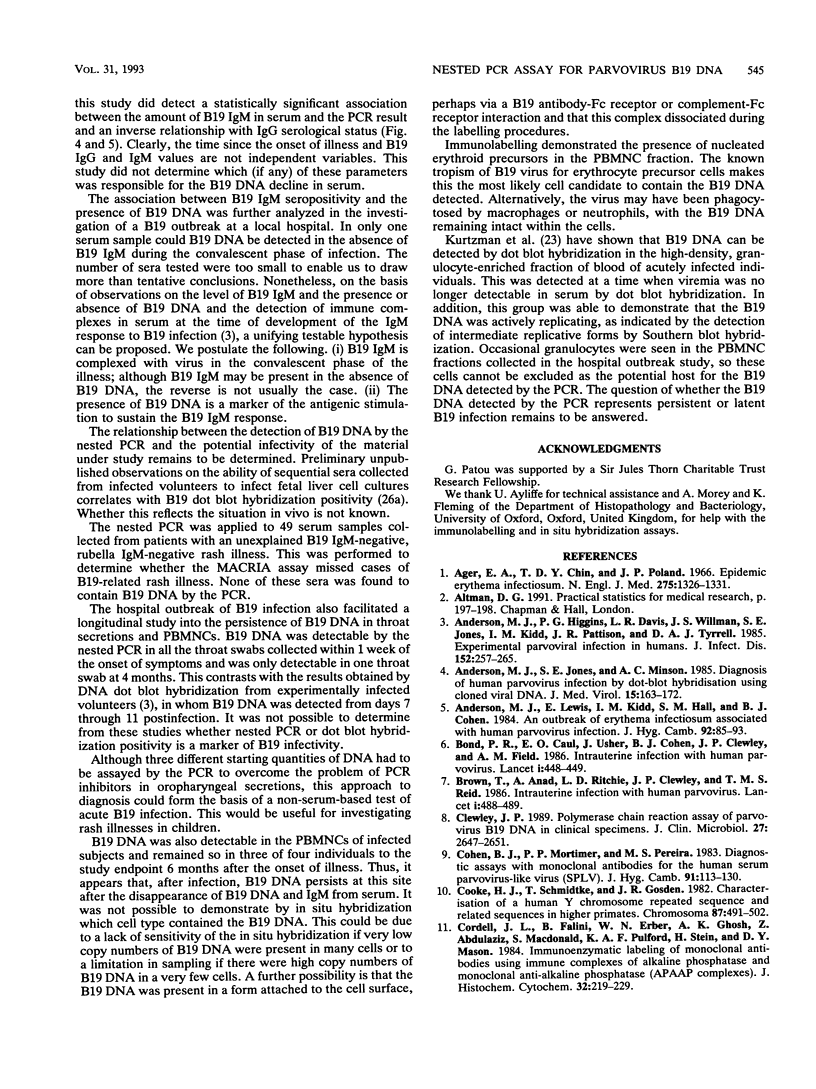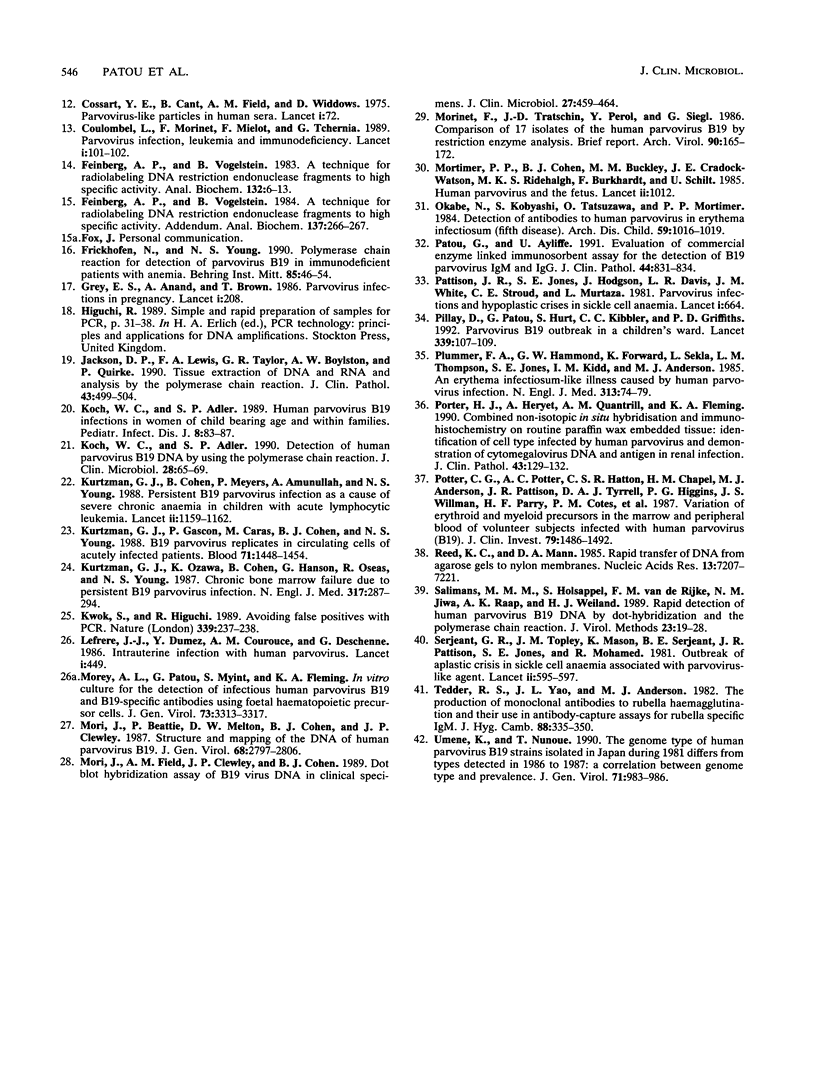Abstract
The characterization and application of a nested polymerase chain reaction (PCR) assay for the detection of human parvovirus B19 DNA is described. The assay was evaluated with 149 diagnostic serum samples (collected up to 150 days after the onset of symptoms) previously tested by dot blot hybridization for B19 DNA and by class-specific capture radioimmunoassays for the detection of B19 immunoglobulin M (IgM) and IgG. B19 DNA was detectable by the PCR in 70% of the sera. There was a statistically significant association between the detection of B19 DNA by PCR and high B19 IgM values (P < 0.005), low B19 IgG values (P < 0.05), and a short interval between onset of symptoms and serum collection (P < 0.005). Serial serum samples, throat swabs, and peripheral blood mononuclear cells collected from 10 individuals during an outbreak of parvovirus B19 were also tested by the nested PCR. B19 DNA was detectable in the throat swabs at the time of the clinical illness and in the peripheral blood mononuclear cell fraction up to the end point of the study 6 months after infection. The location of the B19 DNA could not be determined in cytocentrifuge preparations of peripheral blood mononuclear cells with nonisotopic in situ hybridization and immunolabelling.
Full text
PDF






Images in this article
Selected References
These references are in PubMed. This may not be the complete list of references from this article.
- Ager E. A., Chin T. D., Poland J. D. Epidemic erythema infectiosum. N Engl J Med. 1966 Dec 15;275(24):1326–1331. doi: 10.1056/NEJM196612152752402. [DOI] [PubMed] [Google Scholar]
- Anderson M. J., Higgins P. G., Davis L. R., Willman J. S., Jones S. E., Kidd I. M., Pattison J. R., Tyrrell D. A. Experimental parvoviral infection in humans. J Infect Dis. 1985 Aug;152(2):257–265. doi: 10.1093/infdis/152.2.257. [DOI] [PubMed] [Google Scholar]
- Anderson M. J., Jones S. E., Minson A. C. Diagnosis of human parvovirus infection by dot-blot hybridization using cloned viral DNA. J Med Virol. 1985 Feb;15(2):163–172. doi: 10.1002/jmv.1890150209. [DOI] [PubMed] [Google Scholar]
- Anderson M. J., Lewis E., Kidd I. M., Hall S. M., Cohen B. J. An outbreak of erythema infectiosum associated with human parvovirus infection. J Hyg (Lond) 1984 Aug;93(1):85–93. doi: 10.1017/s0022172400060964. [DOI] [PMC free article] [PubMed] [Google Scholar]
- Bose B., Kerr M., Brookes E. Varicella zoster immunoglobulin to prevent neonatal chickenpox. Lancet. 1986 Feb 22;1(8478):449–450. doi: 10.1016/s0140-6736(86)92410-4. [DOI] [PubMed] [Google Scholar]
- Clewley J. P. Polymerase chain reaction assay of parvovirus B19 DNA in clinical specimens. J Clin Microbiol. 1989 Dec;27(12):2647–2651. doi: 10.1128/jcm.27.12.2647-2651.1989. [DOI] [PMC free article] [PubMed] [Google Scholar]
- Cohen B. J., Mortimer P. P., Pereira M. S. Diagnostic assays with monoclonal antibodies for the human serum parvovirus-like virus (SPLV). J Hyg (Lond) 1983 Aug;91(1):113–130. doi: 10.1017/s0022172400060095. [DOI] [PMC free article] [PubMed] [Google Scholar]
- Cooke H. J., Schmidtke J., Gosden J. R. Characterisation of a human Y chromosome repeated sequence and related sequences in higher primates. Chromosoma. 1982;87(5):491–502. doi: 10.1007/BF00333470. [DOI] [PubMed] [Google Scholar]
- Cordell J. L., Falini B., Erber W. N., Ghosh A. K., Abdulaziz Z., MacDonald S., Pulford K. A., Stein H., Mason D. Y. Immunoenzymatic labeling of monoclonal antibodies using immune complexes of alkaline phosphatase and monoclonal anti-alkaline phosphatase (APAAP complexes). J Histochem Cytochem. 1984 Feb;32(2):219–229. doi: 10.1177/32.2.6198355. [DOI] [PubMed] [Google Scholar]
- Cossart Y. E., Field A. M., Cant B., Widdows D. Parvovirus-like particles in human sera. Lancet. 1975 Jan 11;1(7898):72–73. doi: 10.1016/s0140-6736(75)91074-0. [DOI] [PubMed] [Google Scholar]
- Feinberg A. P., Vogelstein B. "A technique for radiolabeling DNA restriction endonuclease fragments to high specific activity". Addendum. Anal Biochem. 1984 Feb;137(1):266–267. doi: 10.1016/0003-2697(84)90381-6. [DOI] [PubMed] [Google Scholar]
- Feinberg A. P., Vogelstein B. A technique for radiolabeling DNA restriction endonuclease fragments to high specific activity. Anal Biochem. 1983 Jul 1;132(1):6–13. doi: 10.1016/0003-2697(83)90418-9. [DOI] [PubMed] [Google Scholar]
- Frickhofen N., Young N. S. Polymerase chain reaction for detection of parvovirus B19 in immunodeficient patients with anemia. Behring Inst Mitt. 1990 Aug;(85):46–54. [PubMed] [Google Scholar]
- Gray E. S., Anand A., Brown T. Parvovirus infections in pregnancy. Lancet. 1986 Jan 25;1(8474):208–208. doi: 10.1016/s0140-6736(86)90674-4. [DOI] [PubMed] [Google Scholar]
- Jackson D. P., Lewis F. A., Taylor G. R., Boylston A. W., Quirke P. Tissue extraction of DNA and RNA and analysis by the polymerase chain reaction. J Clin Pathol. 1990 Jun;43(6):499–504. doi: 10.1136/jcp.43.6.499. [DOI] [PMC free article] [PubMed] [Google Scholar]
- Koch W. C., Adler S. P. Detection of human parvovirus B19 DNA by using the polymerase chain reaction. J Clin Microbiol. 1990 Jan;28(1):65–69. doi: 10.1128/jcm.28.1.65-69.1990. [DOI] [PMC free article] [PubMed] [Google Scholar]
- Koch W. C., Adler S. P. Human parvovirus B19 infections in women of childbearing age and within families. Pediatr Infect Dis J. 1989 Feb;8(2):83–87. [PubMed] [Google Scholar]
- Kurtzman G. J., Cohen B., Meyers P., Amunullah A., Young N. S. Persistent B19 parvovirus infection as a cause of severe chronic anaemia in children with acute lymphocytic leukaemia. Lancet. 1988 Nov 19;2(8621):1159–1162. doi: 10.1016/s0140-6736(88)90233-4. [DOI] [PubMed] [Google Scholar]
- Kurtzman G. J., Gascon P., Caras M., Cohen B., Young N. S. B19 parvovirus replicates in circulating cells of acutely infected patients. Blood. 1988 May;71(5):1448–1454. [PubMed] [Google Scholar]
- Kurtzman G. J., Ozawa K., Cohen B., Hanson G., Oseas R., Young N. S. Chronic bone marrow failure due to persistent B19 parvovirus infection. N Engl J Med. 1987 Jul 30;317(5):287–294. doi: 10.1056/NEJM198707303170506. [DOI] [PubMed] [Google Scholar]
- Kwok S., Higuchi R. Avoiding false positives with PCR. Nature. 1989 May 18;339(6221):237–238. doi: 10.1038/339237a0. [DOI] [PubMed] [Google Scholar]
- Mori J., Beattie P., Melton D. W., Cohen B. J., Clewley J. P. Structure and mapping of the DNA of human parvovirus B19. J Gen Virol. 1987 Nov;68(Pt 11):2797–2806. doi: 10.1099/0022-1317-68-11-2797. [DOI] [PubMed] [Google Scholar]
- Mori J., Field A. M., Clewley J. P., Cohen B. J. Dot blot hybridization assay of B19 virus DNA in clinical specimens. J Clin Microbiol. 1989 Mar;27(3):459–464. doi: 10.1128/jcm.27.3.459-464.1989. [DOI] [PMC free article] [PubMed] [Google Scholar]
- Morinet F., Tratschin J. D., Perol Y., Siegl G. Comparison of 17 isolates of the human parvovirus B 19 by restriction enzyme analysis. Brief report. Arch Virol. 1986;90(1-2):165–172. doi: 10.1007/BF01314155. [DOI] [PubMed] [Google Scholar]
- Mortimer P. P., Cohen B. J., Buckley M. M., Cradock-Watson J. E., Ridehalgh M. K., Burkhardt F., Schilt U. Human parvovirus and the fetus. Lancet. 1985 Nov 2;2(8462):1012–1012. doi: 10.1016/s0140-6736(85)90558-6. [DOI] [PubMed] [Google Scholar]
- Okabe N., Koboyashi S., Tatsuzawa O., Mortimer P. P. Detection of antibodies to human parvovirus in erythema infectiosum (fifth disease). Arch Dis Child. 1984 Nov;59(11):1016–1019. doi: 10.1136/adc.59.11.1016. [DOI] [PMC free article] [PubMed] [Google Scholar]
- Parvovirus infection, leukaemia, and immunodeficiency. Lancet. 1989 Jan 14;1(8629):101–102. [PubMed] [Google Scholar]
- Patou G., Ayliffe U. Evaluation of commercial enzyme linked immunosorbent assay for detection of B19 parvovirus IgM and IgG. J Clin Pathol. 1991 Oct;44(10):831–834. doi: 10.1136/jcp.44.10.831. [DOI] [PMC free article] [PubMed] [Google Scholar]
- Pattison J. R., Jones S. E., Hodgson J., Davis L. R., White J. M., Stroud C. E., Murtaza L. Parvovirus infections and hypoplastic crisis in sickle-cell anaemia. Lancet. 1981 Mar 21;1(8221):664–665. doi: 10.1016/s0140-6736(81)91579-8. [DOI] [PubMed] [Google Scholar]
- Pillay D., Patou G., Hurt S., Kibbler C. C., Griffiths P. D. Parvovirus B19 outbreak in a children's ward. Lancet. 1992 Jan 11;339(8785):107–109. doi: 10.1016/0140-6736(92)91009-w. [DOI] [PubMed] [Google Scholar]
- Plummer F. A., Hammond G. W., Forward K., Sekla L., Thompson L. M., Jones S. E., Kidd I. M., Anderson M. J. An erythema infectiosum-like illness caused by human parvovirus infection. N Engl J Med. 1985 Jul 11;313(2):74–79. doi: 10.1056/NEJM198507113130203. [DOI] [PubMed] [Google Scholar]
- Porter H. J., Heryet A., Quantrill A. M., Fleming K. A. Combined non-isotopic in situ hybridisation and immunohistochemistry on routine paraffin wax embedded tissue: identification of cell type infected by human parvovirus and demonstration of cytomegalovirus DNA and antigen in renal infection. J Clin Pathol. 1990 Feb;43(2):129–132. doi: 10.1136/jcp.43.2.129. [DOI] [PMC free article] [PubMed] [Google Scholar]
- Potter C. G., Potter A. C., Hatton C. S., Chapel H. M., Anderson M. J., Pattison J. R., Tyrrell D. A., Higgins P. G., Willman J. S., Parry H. F. Variation of erythroid and myeloid precursors in the marrow and peripheral blood of volunteer subjects infected with human parvovirus (B19). J Clin Invest. 1987 May;79(5):1486–1492. doi: 10.1172/JCI112978. [DOI] [PMC free article] [PubMed] [Google Scholar]
- Reed K. C., Mann D. A. Rapid transfer of DNA from agarose gels to nylon membranes. Nucleic Acids Res. 1985 Oct 25;13(20):7207–7221. doi: 10.1093/nar/13.20.7207. [DOI] [PMC free article] [PubMed] [Google Scholar]
- Salimans M. M., Holsappel S., van de Rijke F. M., Jiwa N. M., Raap A. K., Weiland H. T. Rapid detection of human parvovirus B19 DNA by dot-hybridization and the polymerase chain reaction. J Virol Methods. 1989 Jan;23(1):19–28. doi: 10.1016/0166-0934(89)90085-2. [DOI] [PubMed] [Google Scholar]
- Serjeant G. R., Topley J. M., Mason K., Serjeant B. E., Pattison J. R., Jones S. E., Mohamed R. Outbreak of aplastic crises in sickle cell anaemia associated with parvovirus-like agent. Lancet. 1981 Sep 19;2(8247):595–597. doi: 10.1016/s0140-6736(81)92739-2. [DOI] [PubMed] [Google Scholar]
- Tedder R. S., Yao J. L., Anderson M. J. The production of monoclonal antibodies to rubella haemagglutinin and their use in antibody-capture assays for rubella-specific IgM. J Hyg (Lond) 1982 Apr;88(2):335–350. doi: 10.1017/s0022172400070182. [DOI] [PMC free article] [PubMed] [Google Scholar]
- Umene K., Nunoue T. The genome type of human parvovirus B19 strains isolated in Japan during 1981 differs from types detected in 1986 to 1987: a correlation between genome type and prevalence. J Gen Virol. 1990 Apr;71(Pt 4):983–986. doi: 10.1099/0022-1317-71-4-983. [DOI] [PubMed] [Google Scholar]





